YOUR CART
- No products in the cart.
Subtotal:
$0.00

Geshe Thabkhe at the Mind and Life Conference, 2015. All photos courtesy of Geshe Thabkhe.
In September of last year, I had the honor of welcoming four Tibetan monastics and a lay scholar to dinner at my home in Chicago, Illinois. These distinguished guests — Geshe Thabkhe, Geshe Lodoe Sangpo, Ven. Tenzin Legden, Ven. Lobsang Pelmo, Dr. Pasang Tsering — had traveled from India to engage in a collaborative research venture at Northwestern University with neuroscientists Robin Nusslock, Ken Paller, and Marcia Grabowecky. This research venture would use MRI and EEG processes to conduct research on dreaming as well as attention.
The monastics’ invitation to Northwestern came from Professor Nusslock, who wished to collaborate with them at Northwestern’s Cognitive Neuroscience Laboratory. Nusslock recognized that previous research at the crossroads of Buddhism and science positioned Tibetan monks and nuns as subjects of research or research assistants, rather than as leaders in that research.
When we first met, the monastics conveyed a blend of shyness, reserve, and mutual respect. Thabkhe was an amiable presence, displaying curiosity about a wide range of subjects. He and Lodoe Sangpo held senior positions in the group, having achieved the esteemed Geshe Lharampa degree, which is comparable to our Ph.D. Lodoe Sangpo, often quiet, would humbly contribute to our discussions whenever he felt Thabkhe omitted a point. The others generally maintained a subdued presence, but would burst into laughter when Thabkhe recounted incidents from their shared past. Thanks to their shared participation in a number of science workshops over the years, they were far from strangers.
“Tibetan monastic scholars should take the helm in research projects and also be credited for the outcomes of the research,” Thabkhe recalled Nusslock saying. Beginning in September 2022, Nusslock sought to familiarize the monastics with the methodologies of modern neuroscience research, with a particular emphasis on MRIs, EEGs, and other advanced tools.
I was fortunate to engage with these monastic visitors on numerous occasions throughout their visit. During our interactions, I found myself particularly drawn to Thabkhe’s stories. I came to realize that his path to Northwestern could provide insight into the origins, evolution, and future prospects of the ongoing dialogue between Tibetan Buddhism and modern science. Thabkhe has played an integral role within this evolving discourse, making his story a valuable chronicle of the larger intersection of cultures.
While a complete historical account of the intersections between Tibetan Buddhism and Western science would have to include the introduction of scientific knowledge to Tibet in the pre-modern period, the debates within Tibet in the early 1980s regarding Buddhism and science, and His Holiness the Dalai Lama’s decades long dialogues with Western scientists, Thabkhe’s story illuminates the recent evolution of scientific practices and teaching within the Tibetan monastic space in India. Through conversations and interviews, I recorded Thabkhe’s remarkable journey to Northwestern.
Thabkhe was from the village of Penpo, a place of historical significance due to Geshe Potowa (1031 – 1106), one of the three main disciples of Dromtonpa, the founder of the Kadampa lineage of Tibetan Buddhism. Although his village was composed of sixty households, it lacked a local school. Consequently, when he was seven years old, he was sent to a boarding school, where he developed a stronger command of the Chinese language.
His initial exposure to science came from the natural science textbooks in his primary school curriculum. “When I was young, a scientist meant someone wearing a long white coat with magnifying glasses, examining a person or a machine in a room,” Thabke says. “I saw these images in the illustrations from my school textbooks.”
However, Thabke’s formal modern education didn’t extend beyond the third grade. When he turned nine, he joined Sera Monastery, a prominent Geluk institution in Lhasa, the historical capital of Tibet.
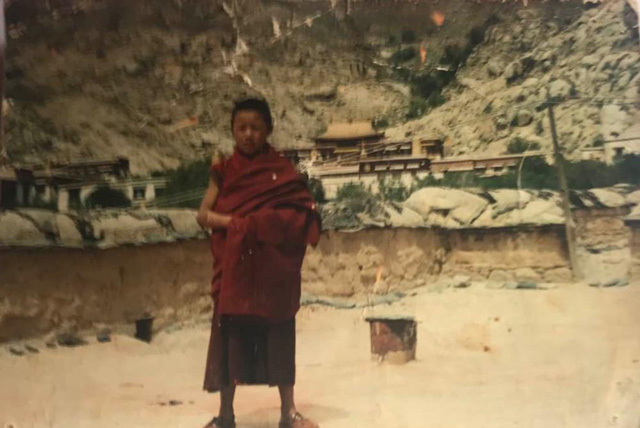
Geshe Thabkhe at Sera monastery Lhasa in Tibet, 1991.
“As per my mother’s wishes, I entered the Sera Monastery at the age of nine, a decision influenced by the fact that my uncle held a prominent position as a senior monk there,” said Thabke. “This was in 1988, and the monastery had not yet been completely rebuilt following the significant damage inflicted during the Cultural Revolution.”
Furthermore, Thabke says the monastery wasn’t fully equipped to accommodate and care for new monks, so he found himself under the care of his uncle. The senior monks were busy reconstructing the monastery during the day, which limited their ability to engage in studies and teachings at night.
The monastery’s curriculum didn’t include science. Instead, Thabke was fully immersed in Buddhist studies.
“My primary focus was on Buddhist philosophy, particularly the ‘Middle Way Philosophy,’” said Thabke. Unfortunately, his studies were significantly disrupted by the Chinese government’s harsh re-education campaign in 1996.
The re-education campaign initiated in May of 1996 targeted Tibetan monastic institutions in the Lhasa region. Government officials were stationed at Sera Monastery for several months, aiming to engage monks in new political study programs. During these courses, the monks were compelled to renounce their allegiance to the Dalai Lama, affirm Tibet as an integral part of China, reject calls for Tibetan independence, and even acknowledge the Chinese-appointed Panchen Lama as their spiritual leader. Noncompliance would result in arrest or expulsion from the monastery.
“I decided to come to India because I didn’t see an optimistic future for my monastic studies if I remained,” said Thabkhe. In 1997, he crossed the Himalayas, finally arriving at Sera monastery in South India.
Thabkhe’s arrival in India marked the inception of his engagement with modern science. After dedicating seven years to his monastic education, a friend of his introduced Thabke to a science workshop organized at Sera monastery in 2004, held by the Science Meets Dharma initiative.
In 1998, the Dalai Lama requested the assistance of the Tibet Institute Rikon in Switzerland to help provide natural science education to Tibetan monks and nuns in India, which led to this initiative. The endeavor heralded the dawn of reforms advocated by the Dalai Lama, who praised their project as “the infrastructure and human resources” essential for Tibetan monastics to learn modern scientific disciplines.
“Delving into science wasn’t my primary objective when I first joined the workshop,” Thabkhe says. “Some of us attended with the intention of improving our English skills. Unlike others, a few of us were curious to witness what insights Western scientists possessed about Tibetan Buddhism. As a result, there were varied motivations behind our initial participation.”
Thabke recalls about 20 participants in that initial workshop, which was led by two Swiss instructors. Due to the monks’ limited proficiency in English and mathematics, they weren’t immediately prepared to learn scientific subjects.
“I distinctly recall that the two teachers chose to teach us English and mathematics during the initial months,” says Thabke. “They even guided us in the art of note-taking. In retrospect, these instructors served as both our first English and science teachers.”
The program persisted for a year, with a schedule of daily, weekly, and monthly sessions that were planned so as not to disrupt the monks’ regular studies. Sometimes, the monks even used their lunch breaks to take part in the workshops.
These science workshops were an entirely novel concept to the broader monastic community, which caused them to encounter some misunderstanding and resistance.
“We had to conceal our science books,” said Thabke. “Fellow monks believed we were learning about crafting bombs, cars, and airplanes. Some of them would jest about this with us quite frequently.”
In reality, Thabkhe and the other participants were discovering whole new realms of knowledge.
“While I had read about Saturn and its rings in school textbooks, I regarded them as nothing more than beautifully rendered illustrations,” he said. “Witnessing the actual rings of Saturn through that telescope was a transformative experience.”
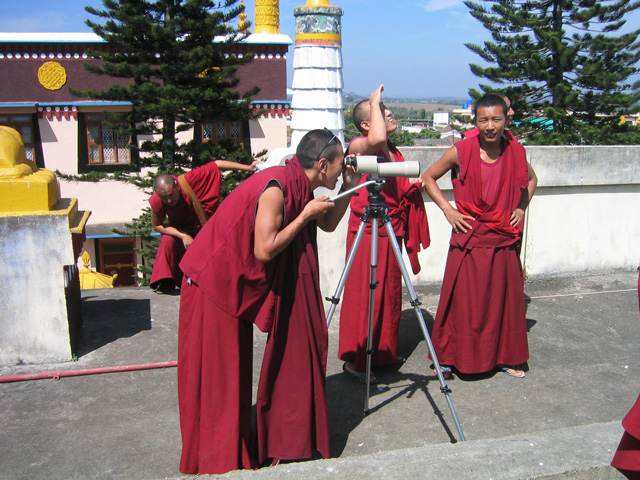
Using a telescope for the first time at Sera Monastery in South India, 2005
A notable challenge for the Science Meets Dharma workshops was the lack of standardized textbooks and scientific dictionaries available in Tibetan. What Thabkhe and his fellow participants gleaned from their teachers depended on the interpretations of young Tibetan college students who, too, lacked Tibetan words for some of the scientific terms presented to them.
Besides Science Meets Dharma, the monastery hosted a different initiative, the Science for Monks workshop. When Thabke took part in one of their sessions, he discovered that they had access to Tibetan translations of scientific writings.
This second workshop was launched by the Library of Tibetan Works and Archives under the guidance of the Dalai Lama. Starting in 2001, the Science for Monks initiative brought Western scientists to India annually to provide training for Tibetan monks and nuns to become science leaders in their communities. This series of workshops continued until 2007, when it transitioned into different projects. This initiative received sponsorship from the Sager Family Foundation. As Thabkhe puts it, “I learned that Bobby Sager and his wife Elaine were inspired by His Holiness the Dalai Lama’s personal interest in science and his vision of enabling Tibetan monks and nuns to embrace new scientific education and dialogue.”
“These workshops facilitated meaningful interactions between us and esteemed scientists, under the supervision of Bryce Johnson, including Chris Impey, Tim Maudlin, David E. Presti, Marieke K. van Vugt, leading to the collaborative publication of two research papers focusing on monastic debate from neuroscientific perspective,” said Thabke, noting that these research projects are still ongoing.
In 2008, they participated in the Science for Monks leadership programs. Their cohort coordinated the first Science Exhibition. Their exhibit, the installation of which was supervised by The Smithsonian Institute, was displayed at various educational institutions across India.
“In hindsight,” Thabke said, “I believe both Science Meets Dharma and Science for Monks laid the essential groundwork for Tibetan monks and nuns to engage with modern science within the confines of their monastic settings.”
Alongside the evolution of the workshops, the Emory Tibet Science Initiative began facilitating the participation of Tibetan monastics in Western science.
“I took part in Emory’s program in 2008 at Sarah College in Dharamsala,” Thabkhe recalls. “We were instructed in fundamental neuroscience, physics, and biology. This initiative led to the translation of course materials and the creation of Tibetan-language textbooks, culminating in the development of a six-year textbook-based curriculum, which later was integrated into the monastic curriculum.”
The Emory Tibet Science Initiative originated in 1998, when the Dalai Lama inaugurated the Emory Tibet Partnership. This initiative was instigated by Geshe Lobsang Tenzin Negi and his advisor, Dr. Robert A. Paul, with the goal of fostering connections between Western and Tibetan traditions. The Dalai Lama’s delivery of the 153rd Commencement Address at Emory in 1998, along with subsequent visits, cemented a strong bond between Emory University and Tibetan monastic institutions in India.
According to Thabkhe, the monks at these workshops “often engaged in spirited discussions with their teachers, often sharing insights from Buddhism. Some even held the belief that science might undermine the teachings of Dharma; such attitudes still persist among many monks.”
To advance the Emory Tibet Science Initiative, Geshe Lobsang Tenzin Negi and others emphasized the importance of preparing monastics to become future educators, rather than relying on external parties, in particular Western professors. From the outset, they recognized that bringing Western scientists to Tibetan monasteries in India annually might not pose a challenge, but this alone wouldn’t fulfill their overarching mission. Thus, in 2010, six erudite monks were invited to Emory University to pursue modern science as undergraduates. This initiative marked a pioneering step toward revolutionizing the way Tibetan monastics engage with modern science.
Enrolling at Emory marked a significant advancement in the monks’ education, prompting them to adopt a more critical approach and gain a deeper understanding of diverse traditions. As Thabkhe prepared to embark on the next stage of his journey, a blend of excitement and concerns emerged.
“I viewed it as an exceptional opportunity to delve into genuine scientific learning,” he said. “Yet simultaneously, I grappled with apprehensions about whether I could meet the expectations of His Holiness the Dalai Lama, the organization, and even the sponsors.”
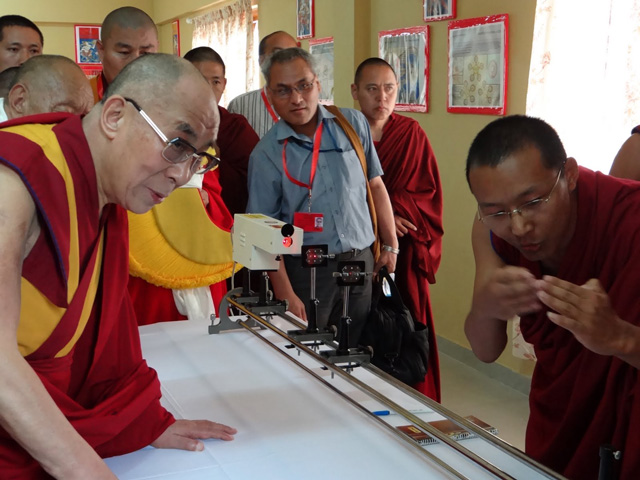
Describing an experiment to HH the Dalai Lama at Sera Jey Science Centre, 2013.
At first, using computers and understanding email systems posed a challenge for Thabke. Beyond their language proficiency, they were navigating an unfamiliar cultural terrain.
“Upon our arrival, the University conducted a brief interview with us. One of the questions asked was about our preferences for American cuisine,” Thabke said, laughing.
“Our response? ‘Pizza.’”
Subsequently, whenever the cohort received invitations to visit professors’ homes, they found themselves being offered pizza. They didn’t particularly enjoy pizza — it was simply the sole American dish they could readily name.
Yet academics took up most of their time. “Throughout our tenure at Emory, our days revolved around a constant cycle of attending classes and diligently completing homework,” said Thabke.
“We hardly found a moment to enjoy the swimming pool or other recreational facilities.”
In contrast to their monastic educational experience, the routine at Emory dictated that after each lecture, they would proceed to the lab to work alongside fellow students.
“This was an entirely novel practice for us,” Thabkhe says. “Amidst the various challenges, we encountered particular difficulty with a physics course, struggling to meet homework deadlines.”
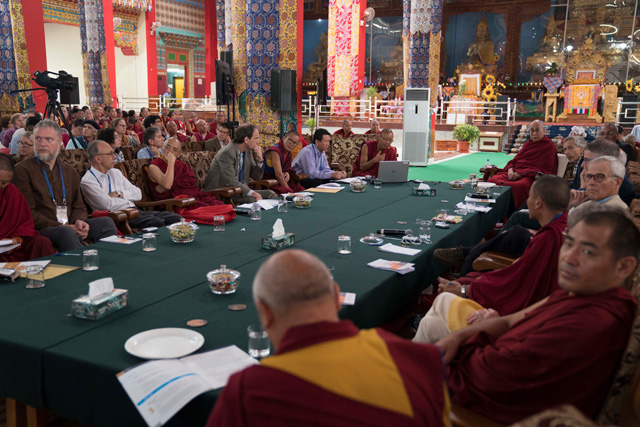
Presenting “Causal Factors for the Origin of the Universe” at Emory-Tibet Symposium, 2016.
For Emory students, Thabke recalls, finishing lab assignments usually took under 30 minutes, but for the monks, it extended beyond two hours, sometimes prompting instructors to start a round of card games or play solitaire on their computers while waiting for the monks to finish.
Emory University fostered a robust foundation in modern science for Thabkhe and his colleagues. They no longer sought to superimpose Buddhist concepts upon scientists, but rather to grasp Western theories to enrich their own understanding of Buddhist principles.
“Reflecting on my three-year journey at Emory, it truly revolutionized my perception of modern science,” says Thabke.
“Prior to my time there, I held the belief that science solely concentrated on the material realm, while Buddhism primarily delved into the inner world.”
“However, … I discovered that modern science has ventured into new domains, delving deeply into inner realms such as attention, consciousness, dreams, and overall mental well-being.”
Following his Emory graduation as a Tenzin Gyatso Scholar, Geshe Thabkhe returned to India to finish his Geshe Lharampa degree, the highest accolade in Tibetan Buddhism.
“When I arrived at Emory to delve into modern science, I came to a complete halt in my pursuit of monastic studies, as juggling both proved to be an insurmountable challenge,” he said. “Upon my return to India, I intermittently provided instruction in basic physics and the philosophy of science to the monks engaged in scientific studies.”
Thabke has participated in Mind & Life Institute conferences since 2008, even participating in a group panel at the 20th anniversary of the program. The Emory Tibet Science Initiative continued conducting their two-month summer workshops for the monks, during which he frequently assumed the roles of teaching assistant and interpreter. He also volunteered as a teaching assistant for the Science for Monks workshop on occasion, and was invited to deliver presentations on science at different Tibetan monasteries in South India.
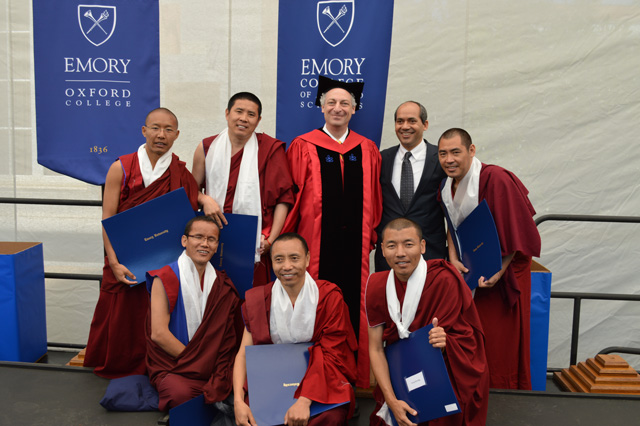
Emory University Commencement Day, 2013
Throughout these experiences, he encountered the same phenomenon: a number of novice monks inclined to engage in debates with their science instructors, utilizing Buddhist reasoning.
“I believe this is a natural inclination that emerges before fully immersing oneself in the realm of modern science,” he says.
Over several years, the evolution has been significant–science research centers have sprouted within Tibetan monasteries, and the inclusion of science in monastic studies was officially introduced in 2018, marking a revolutionary shift in the landscape of Tibetan Buddhist education. In contemporary times, obtaining your Geshe Lharampa degree requires passing science examinations. It was an unprecedented moment in the 1200-year history of Tibetan Buddhism: the first-time modern science was formally introduced into monastic education.
Coincidentally, 2018 also marked a significant moment in Thabkhe’s life, when he achieved his Geshe Lharampa degree. He was the first rank amongst his contemporaries in all the examinations for six consecutive years, writing a new chapter in the history of his monastic studies.
During our initial gathering at my home, Thabkhe explained how coming to Northwestern marked the fourth stage in the monastics’ journey.
During their three months’ stay at the university, they acquired proficiency in utilizing MRI, the complete EEG process, and conducting research on dreaming as well as attention. Their central focus has been on lucid dreaming, a subject of considerable attention within the domains of neuroscience and psychology today.
Their research objective was to combine insights from Tibetan dreaming practices with a psychophysiological approach. As outlined in Professor Paller’s research proposal, “This combination is pivotal for attaining a more profound comprehension of how advanced Buddhist practitioners attain potential positive outcomes.”
The research group aimed to fathom the reasons behind humans’ need for dreams and their potential benefits, seeking to explore the contributions of Tibetan Buddhist practices, such as dream yoga.
“In essence, the research endeavored to examine dreams through the lenses of both traditions,” says Thabkhe.
Each Wednesday evening, the monastics were tasked with making all the necessary preparations for the lucid dreaming experiments. At the lab, about an hour before sleep, they set up the EEG, which entails attaching cables to the scalp, ensuring appropriate measurement between each cable, and verifying the functionality of the communication between the cables and the computer.
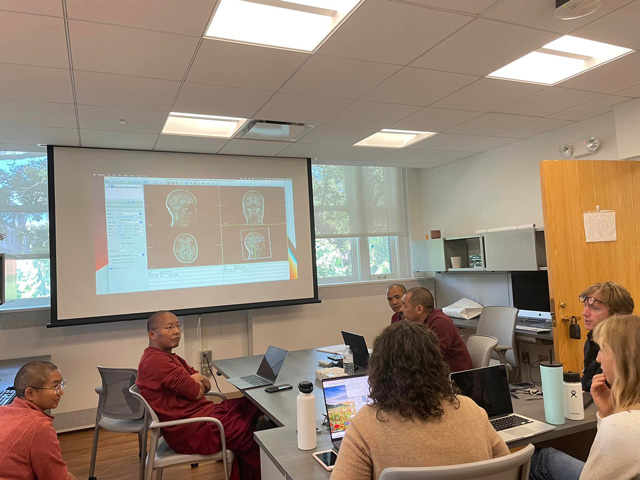
Discussing MRI Procedures at Northwestern University, 2022.
The research duties were shared in a rotation; two monastics were assigned for the initial two-hour period, while the others later took their place in the lab. The dreamers underwent training before sleeping, involving specific auditory cues. Throughout sleep, the dreamers would engage in designated tasks such as signaling when experiencing dreams, recognizing dream states, or practicing meditation in dreams. Meanwhile, the two individuals stationed by the computer monitored for indications of REM sleep and intermittently interacted with the dreamer.
When the second group assumed their shifts, the dreamers were awakened and provided with instructions before resuming sleep for the next two hours. Upon waking, an interview was conducted. They would later reconvene to scrutinize the data, analyzing both the computer records and the interview insights.
“Participating in the research proved to be an enriching experience, in contrast to being the subject of research,” Thabkhe says.
“In broad terms, Buddhist dream yoga encompasses practical techniques for cultivating lucid dreaming, leveraging lucid dream states to engage in various contemplative practices with specific goals, and recognizing corresponding perceptual shifts during wakefulness,” says Thabke.
“For instance, a 12th-century Tibetan Buddhist master, Kyunpo Naljor, prescribed a six-fold procedure for dreamers to follow, involving recognizing, training, enhancing, emanating, transforming, and confirming objective appearances. Each step is accompanied by detailed instructions for practice during lucid dreams.”
What these researcher monastics initiated at Northwestern University merely scratches the surface and the research is anticipated to continue for several years.
“I’m hopeful that future collaborations and exchanges between Western scientists and Tibetan monastic scholars will thrive,” says Thabke.
As Thabkhe’s journey shows, the foundation for merging modern science and Tibetan Buddhism has been laid by His Holiness the Dalai Lama, opening avenues for a better and healthier world. Yet, the responsibility for the future rests with Tibetan monastic scholars, institutions, and Western scientists.
In Thabkhe’s words, “I am convinced that upholding the Dalai Lama’s legacy is vital to shaping a more promising world for all through the collaboration of these two traditions.”